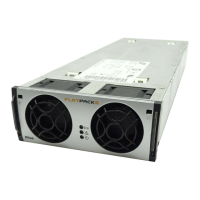3 Installation of Flatpack2 Rectifiers
14 User’s Guide Flatpack2 Rectifier Modules, 350002.013, 7v0-2010-09
Connections
All connections are implemented by inserting the Flatpack2 module fully into the power
shelf, thus plugging the rectifier to the self’s back wiring card (hot-pluggable).
Figure 5 Flatpack2 module’s rear plug-in connections to power shelf’s back wiring card
For details about other power shelf signals, type of power shelf, etc., please read the
system’s generic and specific documentation, or contact your dealer or Eltek Valere
representative.
CAN Bus Addressing (plug-and-play)
When a Flatpack2 rectifier is hot-plugged in the power shelf the first time, the system’s
main controller automatically assigns the rectifier with the next available ID number
(CAN bus address). The rectifier will retain its ID (and serial number), even after
removing and reinserting it in the power shelf.
The rectifiers’ IDs are assigned from 1 and upwards. When a module is plugged in, the
system’s main controller automatically increases the number of communicating rectifiers
in the CAN network.
Correct Rectifier Position in Power Shelves
Flatpack2 DC power systems are usually shipped from factory with the rectifier modules
already installed in the correct position in the power shelves, with respect to their CAN
bus address or ID number.
This relationship is very important for the correct monitoring of the mains three phases,
as the system’s main controller always uses rectifier ID 01, 02 and 03 to monitor mains
phase L1, L2 and L3 respectively. If these rectifiers malfunction, rectifier ID 04, 05 and
06 will automatically take over.
For example: accidentally inserting a rectifier with ID 02 in a power shelf position
internally connected to mains phase L1, will cause the controller to monitor L1 “thinking“
it monitors L2.
Firmware Upgrade of the Rectifier Modules
Please, contact Eltek Valere Service Dep. if you need to upgrade the rectifiers’ firmware.

